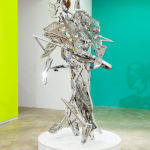-
Artworks
Tomokazu Matsuyama Japan, b. 1976
Runner, 2021Stainless steel96 x 36 x 36 in
243.8 x 91.4 x 91.4 cmEditions of 3 + 1 AP8162Further images
-
(View a larger image of thumbnail 1
)

-
(View a larger image of thumbnail 2
)

-
(View a larger image of thumbnail 3
)

-
(View a larger image of thumbnail 4
)

-
(View a larger image of thumbnail 5
)

-
(View a larger image of thumbnail 6
)

-
(View a larger image of thumbnail 7
)

-
(View a larger image of thumbnail 8
)

-
(View a larger image of thumbnail 9
)

-
(View a larger image of thumbnail 10
)

-
(View a larger image of thumbnail 11
)

-
(View a larger image of thumbnail 12
)

-
(View a larger image of thumbnail 13
)

-
(View a larger image of thumbnail 14
)

-
(View a larger image of thumbnail 15
)

-
(View a larger image of thumbnail 16
)

-
(View a larger image of thumbnail 17
)

-
(View a larger image of thumbnail 18
)

-
(View a larger image of thumbnail 19
)

-
(View a larger image of thumbnail 20
)

This sculpture, titled Runner, debuted in The Best Part About Us, Tomokazu Matsuyama’s 2022 solo exhibition at Kavi Gupta gallery in Chicago. The form is highly abstracted, offering not so...This sculpture, titled Runner, debuted in The Best Part About Us, Tomokazu Matsuyama’s 2022 solo exhibition at Kavi Gupta gallery in Chicago. The form is highly abstracted, offering not so much a narrative expression of a runner, but rather a poetic incarnation of certain ideas about the function and cultural meaning of running as part of human culture. Viewed from certain angles, the sculpture reveals aspects of a human form, such as a head, arms, and feet that don a pair of athletic shoes. Other aspects of the form are intended to convey movement and action. This work is a companion to a sculpture titled Dancer. Matsuyama placed these two forms in the same space as an expression of how dancing and running are separate activities that nonetheless express similar human interests. Dancing is more prevalent in Eastern Culture, while running is more a part of Western culture. Nonetheless both activities allow people to express similar human ideals. Matsuyama’s sculptural practice is informed by his process of questioning how his imagery might be experienced by viewers in three-dimensional space. He contemplates the total optical experience of his paintings and the logical relationships of the formal elements within them, creating mirrored forms and patterns that serve as an optical metaphor for his vision of cultural exchange and influence. The effect event extends beyond the piece, as its surfaces will take on the colors of its environment. Simultaneously familiar and alien, Matsu’s sculptures hint exquisitely at the worlds we know, if not from life then from a memory or from a dream. Hand welded from sheets of stainless steel and hand buffed to a mirror shine, these fragmented, labyrinthine forms are frozen in gestures that, again, relate to the “global us.” In their distorted, curvilinear surfaces we see ourselves and wonder, like a glimpse into the Matrix, which side of the mirror is real.Exhibitions
Tomokazu Matsuyama: The Best Part About Us, 2022. Kavi Gupta | Elizabeth St, Chicago, IL, USA
-
(View a larger image of thumbnail 1
)



















